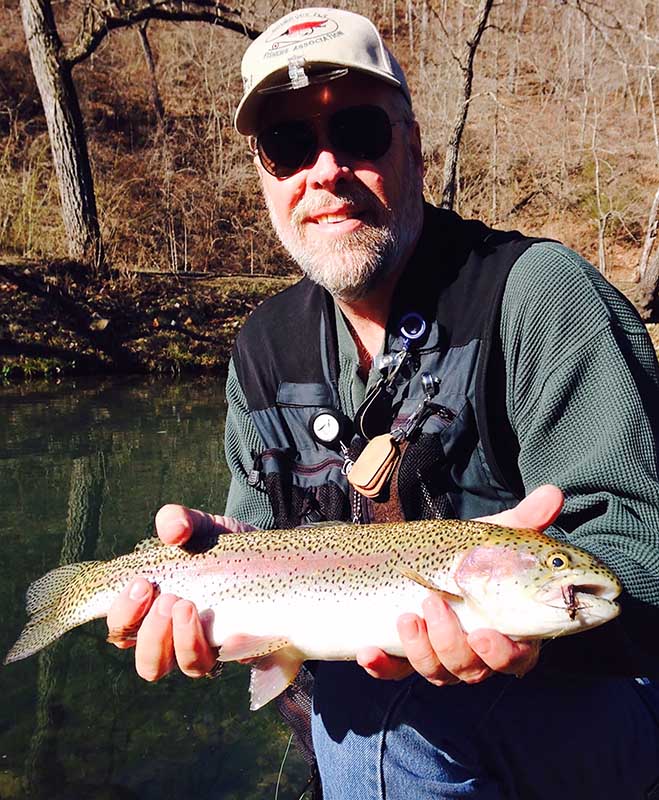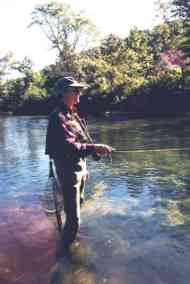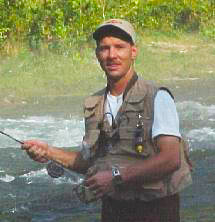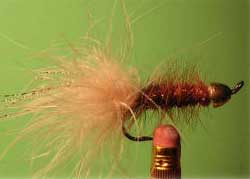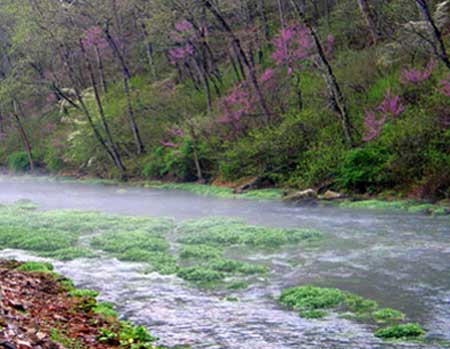
Fly fishing Tips from Denis Hancock
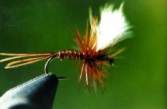
Denis Hancock is a 20 year veteran of fly fishing and likes the North Fork because it resembles some of the rivers in Colorado, where he spent several years while in school. Denis enjoys all forms of fly fishing and prefers a hair-winged
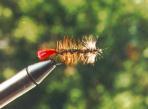
fly (i.e. Royal Wulff, Pheasant-Tail Wulff) for trout and a Grizzly Bear fly for bass in the Spring, Summer, and Fall.
During the Winter, he will switch to a Pheasant-Tail Nymph, if the surface action is slow. Denis finds the current seams to be the most productive, and if the trout are looking up, then this is where the dry fly action will be.
Summer Fly Fishing Tips from Mark Van Patten
During the heat of the summer the fish will congregate in deep pools just below a good riffle. The riffle will provide much needed oxygen and the deep pools provide cooler temperatures as well as an escape from the sunlight that mortifies trout. A sinking tip line or a sinking head placed above the pool and allowed to drop deep into the pool should produce results. Try using a larger Prince or Anderson rubber leg stone. Use a tight line drift with a longer leader. (9-10 ft) You need to keep the fly line off of the water and keep a direct line with the fly. The complex cross currents at the head of a pool will cause your fly line to drag and not allow the fly to drift naturally or deep enough. The take will be subtle at best. You can use a strike indicator right where the leader and fly line connect to aid in seeing a soft take.
Never take your eyes off of the indicator. It is very easy to miss the take. Once that monster has taken it and spit it out, he won’t be fooled again. You get one shot.
If this does not produce, position yourself in the riffle and let out line directly below you into the pool. Allow a large dark woolly bugger (black or dark olive) to drop deep into the pool and retrieve with very short and relatively slow strips back to you. You need to get deep, keep a low profile, and work slow no matter what you use. Once again the take will be very soft. If you feel anything at all, or notice any movement not consistent with the drift, set the hook.
I just finished filming some segments for my show and used these tactics with very good results. I have used them for years and am convinced of their validity.
I hope this tid-bit of info helps someone land the “Summer trout” of their dreams at ROLF on the North Fork.
Mark
Mark Van Patten
Streams Coordination Biologist
Missouri Department of Conservation
573-751-4115 ext. 3892
Trout Fishing Tips from Russ
Russ has been fishing the North Fork since 1981 and has the following tips on flies and tackle.
In the Spring Russ likes to find the big stone flies laying their eggs and then throws a Stimulator in color to match; either yellow or orange. Since these flies live several years in their nymphal stage, a black stonefly nymph or black rubber legs in various sizes will work all year long.
Russ likes to keep his flies simple so losing one doesn’t break his cheap heart. Later in the spring when the water drops and clears a little Russ likes a #18 parachute Blue Winged Olive or parachute Adams. Also the #16 to #18 Elk Hair Caddis comes into it’s own around this time. Russ has seen some Red Quills come off of the river in the spring and also small Light Cahills.
Basically lots of the Eastern mayflies are present on the North Fork with a few exceptions. Russ hasn’t seen any Hendricksons or Green Drakes but wouldn’t be surprised to. Since the North Fork has a bedrock bottom it’s unlikely to find many burrowing types of mayflies.
Summer brings out the Tricos and fishing their spinners on a summer morning is fantastic. Don’t expect to see the big bruisers come up for them but expect lots of fish. A 22 or 24 pattern works fine. Again the para BWO and Elk Hair Caddis work well during this time. Again throw a small Cahill when you see tiny tan mayflies coming off. Russ’ best fish was a 21 inch brown caught on a 16 BWO fished down and across during a hatch. Drift a Prince nymph as a dropper behind a black rubber legs in the fast water and watch your strike indicator! Fall is streamer time for the browns when they move upstream to spawn.
Russ has had good luck with a black Marabou Muddler but a black or olive Wolly Bugger will move some fish too. Russ will throw an olive Wolly Bugger all season. This time of year Russ has seen some huge mahogany duns flying upstream so have some of then tucked away.
For the Fall, Russ digs out Black Rubber Legs and olive Brown and Black Woolly Buggers out of his fly box. These flies have proven themselves as productive over Russ’s 19 years on the North Fork.
Winter means low and slow and again a black rubber legs or stonefly nymph. Don’t be surprised to see some top water action and have some Griffiths Gnats or tiny Baetis imitations in your box. Russ throws a five weight with a floating weight forward taper but wishes he had a seven for the big Wolly Buggers. Chest waders with felt or lug soles are a must and even then be within a short walk of dry clothes as the river has a very uneven slick bedrock bottom. Fish the deep fast water for the rainbows and the slower deep water for the browns but the fish can be anywhere. Russ hasn’t tried night fly fishing for the trophy browns but it’s just a matter of time until he does and then he will throw a big brown or black Wolly Bugger or Marabou Muddler or crayfish pattern.
T. Russ
Barry’s Annalora’s North Fork Fly Fishing Tips
Barry is one of ROLF’S most successful dry fly fishermen. He comes three or four times a year and always does well. The North Fork is one of Barry’s favorite trout fishing stream.
For the hot Summer mornings, Barry’s fly preferences are as follows:
Early Morning Dries:
Olive trude #16
Blue dunn #18
Black trico #18
Wet Flies:
Caddis pupa #16
Sow bug #16
During the Fall months, Barry sees the most action with:
Dries:
Mosquito #14
Adams #14
Wet Flies:
Prince (bead head) #14
C.R. gold #14
Barry wishes to pass on an important tip concerning weight: “Use as little as possible, generally a #6. Also use a light tippet, say a 6X or 7X.”
Myron’s General Fly fishing Tips
Nymphing is generally the most consistent way to catch North Fork trout. The local’s favorite is the bead-head Prince nymphs and brown Woolly Buggers in various sizes. Don’t forget that Crayfish are also an important spring and summer time food for the trout.
July on the North Fork brings on the weighted hellgrammite nymphs as a fly of choice. During May the light Cahill hatch provides great dry fly action, but trout will also generally strike caddis or stoneflies at anytime. Skating an Elk Hair Caddis across the surface remains a proven method on the North Fork to generate a strike.
Do you need some assistance in tackle selection?
Here are some recommendations.
Further inquires or the latest hot fly selection info may be obtained from Myron.
Need a Missouri Fishing License? Call 800-392-4115 or visit the Missouri Department of Conservation website
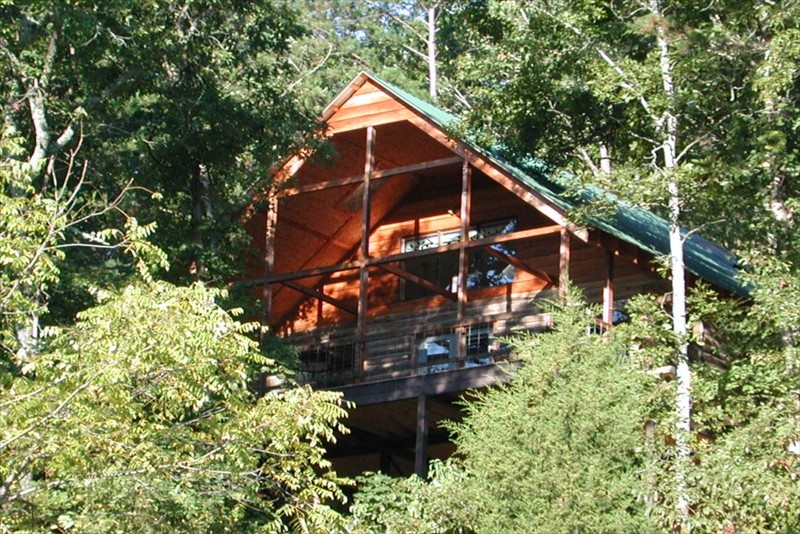
Missouri Fly Fishing Lodging
River of Life Farm offers many lodging selections to choose from. We can accommodate from 1 to 14 guests. After a great day of fishing, relax in our comfortable cabins secluded in the scenic Ozarks.


